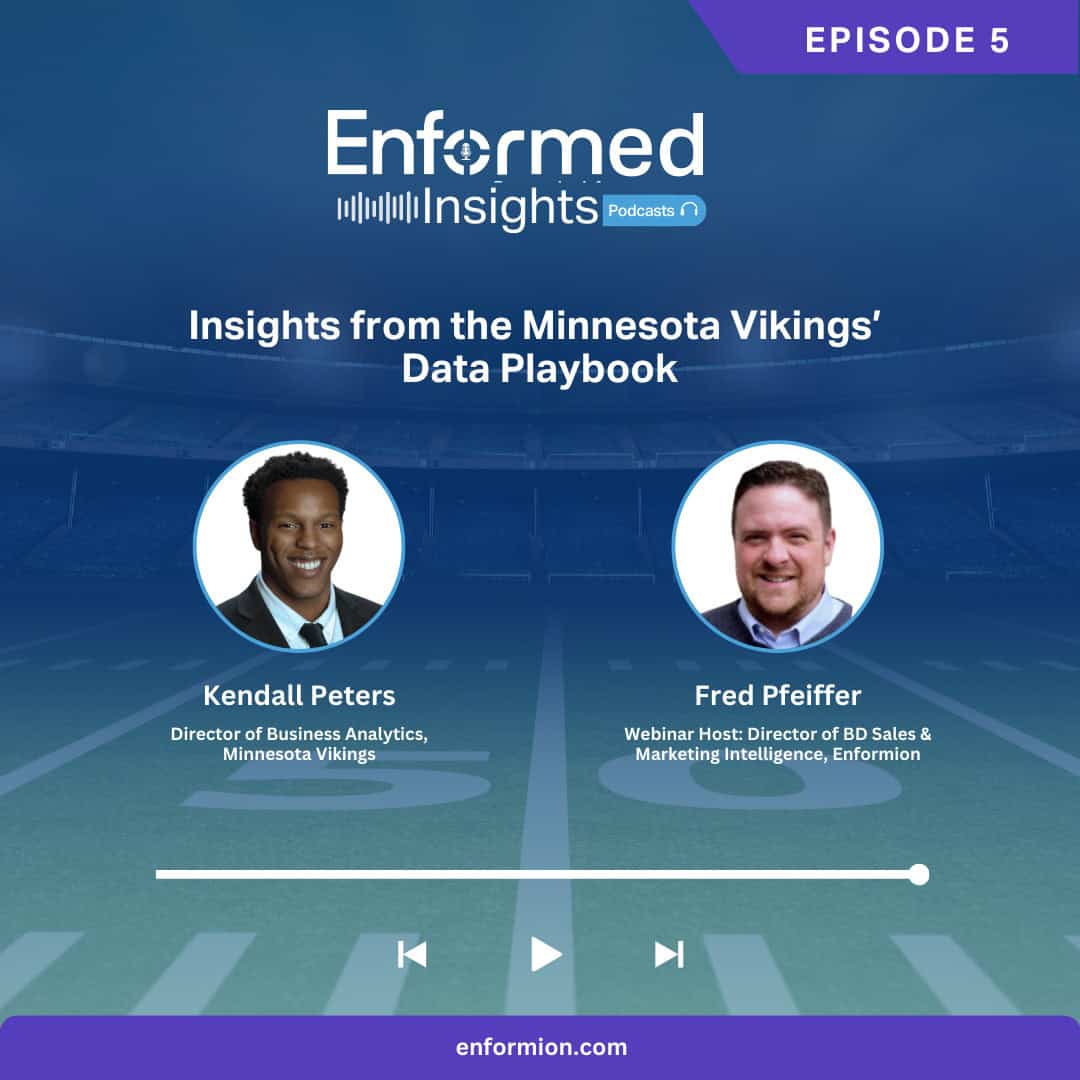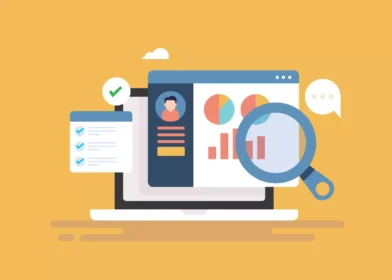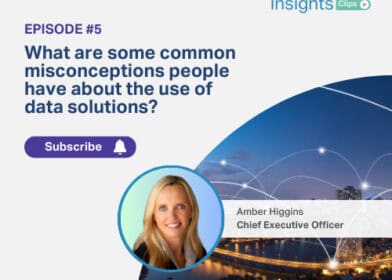Episode 5: Insights from the Minnesota Vikings’ Data Playbook

Stream on these platforms:
Click play below to listen:
Join us for another episode of Enformed Insights, where we interview industry experts and gain personal insights into how they find success in their fields. In this episode, we sit down with special guest Kendall Peters, Director of Business Analytics for the Minnesota Vikings, as he shares his experience in the sports business and data analytics industries. Kendall’s background and education in sports data analytics has provided him with an in-depth understanding of customer trends, partnerships, and information management, and how it all contributes to maintaining and growing the success of their brand.
Key Discussion Points:
- Moving away from guesswork to make confident, data-driven decisions
- Utilizing brand partnerships to better understand customer behavior
- Staying engaged with your target audience
- Crafting relevant marketing messages based on customer insights
Welcome to Enformed Insights, the official podcast of Enformion.com and your guide to the world of public records and data analysis. Join our host, Fred Pfeiffer, as he interviews industry experts and shares practical tips for navigating the future of digital information.
0:18
Fred: Kendall Peters, welcome to the Enformed Insights podcast. It’s great to have you here. To start, could you share some insight into your background and your role as the Director of Business Analytics for the Minnesota Vikings?
0:30
Peters: Yeah, absolutely. I mean, I can share a little bit about myself. I started as an intern with the Orlando Magic, and from there became an analyst with the Vikings in 2015. I’ve been with the Vikings since then, and I’ve always been in sports but have grown in responsibility over the past decade or so.
1:01
Peters: I’ve always been in an analytics-focused role, though it’s varied between areas like sales and fan experience. As my role expanded, it’s become more focused on organizational impact—using insights to drive strategy.
1:27
Peters: Data is great, but if it doesn’t get converted into value for stakeholders, it’s a waste of time and resources. Turning data into value often involves communication, visualization, and one-on-one conversations to truly understand stakeholders’ needs.
1:51
Fred: Analytics are obviously important for the team on the field. Could you give us an overview of how the Minnesota Vikings utilize data analytics in their business operations?
1:57
Peters: We essentially split analytics between football and non-football aspects. Football has its own analytics team. On the business side, we focus on the fan experience and internal operations. Our goal is to ensure we’re delivering the best possible value for fans and making data-driven decisions aligned with our mission and values.
2:19
Peters: We want our smart, talented staff making confident decisions instead of educated guesses. With analytics, we aim to boost metrics like fan sentiment, engagement, partnerships, and sales.
2:54
Peters: One of our main initiatives is clustering our fan base using machine learning to create six different personas based on demographics, psychographics, and qualitative data. This way, our team can communicate more effectively and tailor messages to specific fan values and preferences.
4:22
Fred: Could you share more about how data analytics enhances fan engagement, specifically?
4:26
Peters: Definitely. We look at fan engagement as a journey with three stages. First, it’s about the number of fans we’re reaching across platforms like social media and email. Next, we focus on fan sentiment—how they feel about the Vikings—through surveys and polls. We then use this data to adjust our strategies.
5:31
Peters: At a more granular level, data influences our in-stadium experience, game presentations, and digital engagement. For example, if a segment of fans feels disconnected, we can prioritize engagement strategies for them and measure our progress.
6:07
Fred: Can you give a specific example of how data has influenced fan experience, whether at the stadium or digitally?
6:12
Peters: A few years ago, data showed us that only 20-30% of people in the stadium were season ticket members, meaning the majority of attendees were unique each game. This insight shifted our programming to engage all fans, not just repeat visitors.
7:01
Peters: Knowing that 70% of attendees might be first-timers or one-time visitors has a huge impact. For sponsors, it’s valuable to reach unique fans every game. For our team, it reinforces that we need to make every single game experience impactful.
8:14
Fred: With so much change happening, especially post-COVID, are you seeing similar patterns with data collection? What kinds of consumer data do you track, and how do you keep it updated?
8:20
Peters: We collect data through ticketing, concessions, merchandise, and digital interactions. Ticketing is a big one, but we also rely on partnerships with vendors like Ticketmaster and Fanatics for more detailed information. We centralize everything in a data warehouse to get a holistic view of fan interactions.
9:39
Peters: Year-over-year trends are essential, but we also look at long-term projections. We’re constantly monitoring and adapting based on fan behavior, economic trends, and more. It’s a dynamic process.
11:00
Fred: Can you share a case study where data-driven marketing boosted engagement or sales, whether in tickets, merchandise, or any other area?
11:06
Peters: Sure! Retention is a big focus for us. We noticed some metrics slipping among our season ticket members, so we conducted research and A/B testing to understand what changes were needed. This led us to make new investments in our season ticket experience, which has boosted retention rates.
11:59
Peters: With season tickets effectively sold out, our data insights ensure that we’re keeping members engaged and invested in the long term, not just for one season.
12:37
Fred: We recently spoke with Will Alber of the NFL about keeping core identity markers like name, email, phone, and address up to date. How does the Vikings team manage that?
12:49
Peters: Ticketing helps us identify fans initially, but we’ve designated this as the “year of lead generation” to drive engagement beyond that. We capture leads through various means, from contests to signups, and progressively profile them. Once we get core identifiers, we focus on deeper insights like fan values and lifestyle preferences.
14:03
Peters: We aim to move fans through stages of engagement: awareness, identification, and then deeper personalization. By building a complete profile, we can tailor interactions and make fans feel valued enough to share more about themselves.
14:26
Peters: The end goal is to foster a meaningful connection with our fans, enabling us to meet them where they are and adapt as they change.
15:08
Peters: We bring data into our email service platform and start journeys, gathering progressive profiling information from there. It’s not exactly part of identity resolution, but we do value our fans and use modeling to assign value based on how they connect with us. This helps us decide on further investments in look-alikes or similar fan groups.
15:40
Fred: The Vikings have a long, rich tradition with many Super Bowl appearances in the ’70s. Fans across the country follow them, similar to teams like the Bears or Cowboys. How do you address the differing needs of local fans versus those who engage on a national level?
16:01
Peters: That’s a great point. A lot of our revenue, particularly from ticketing and attendance, comes locally. But we recognize the importance of our national and even international fans. We hold the international rights for the U.K. and Canada, so we work on building fan relationships there too. While we can’t bring U.S. Bank Stadium to them, we aim to make merchandise accessible through our partnership with Fanatics, which has a broad reach.
17:16
Peters: We also have official “fan networks” with watch bars and groups around the country. We’ve done extensive research to understand what motivates these fans. Each of them is crucial, but these network leaders often help us grow engagement in places far from Minnesota.
18:18
Fred: What’s the biggest challenge in collecting and analyzing consumer data today, and how do you address that?
18:24
Peters: I’d say there are two angles. Externally, data privacy laws add complexities, and we work hard to be compliant. Internally, the “curse of the analyst” is turning data into actionable insight. Data on its own isn’t valuable until it becomes strategy. I constantly work with my team and leadership to communicate the significance of our findings effectively.
20:03
Fred: What advice would you give to someone pursuing a career in sports analytics?
20:07
Peters: I’d say to have empathy. Understanding the pain points of your end users—whether fans, sellers, or service teams—builds trust. When they know you’re working to make their jobs easier or solve real problems, they’ll trust the insights and data you bring.
21:04
Fred: With recent changes, like Kirk Cousins leaving and Sam Darnold and JJ McCarthy stepping in, does that impact your role?
21:30
Peters: Not directly, but we’re always monitoring fan sentiment. Changes like this influence how fans feel, so we stay aware and adapt our messaging, marketing, and sales approaches accordingly. Right now, there’s optimism about the new team structure.
22:06
Fred: As a Bears fan, I think the NFC North is going to be highly competitive. It’ll be interesting to see where each team heads over the next few years. Thank you for your time, Kendall. Where can listeners find you if they’d like to connect?
23:29
Peters: The best way is LinkedIn—just look up Kendall Peters, Director of Business Analytics for the Vikings. I’d be happy to connect.

Ready To Get Started?
Contact us today to request a demo or to get in touch with one of our Data Solution Experts
Talk With Us

